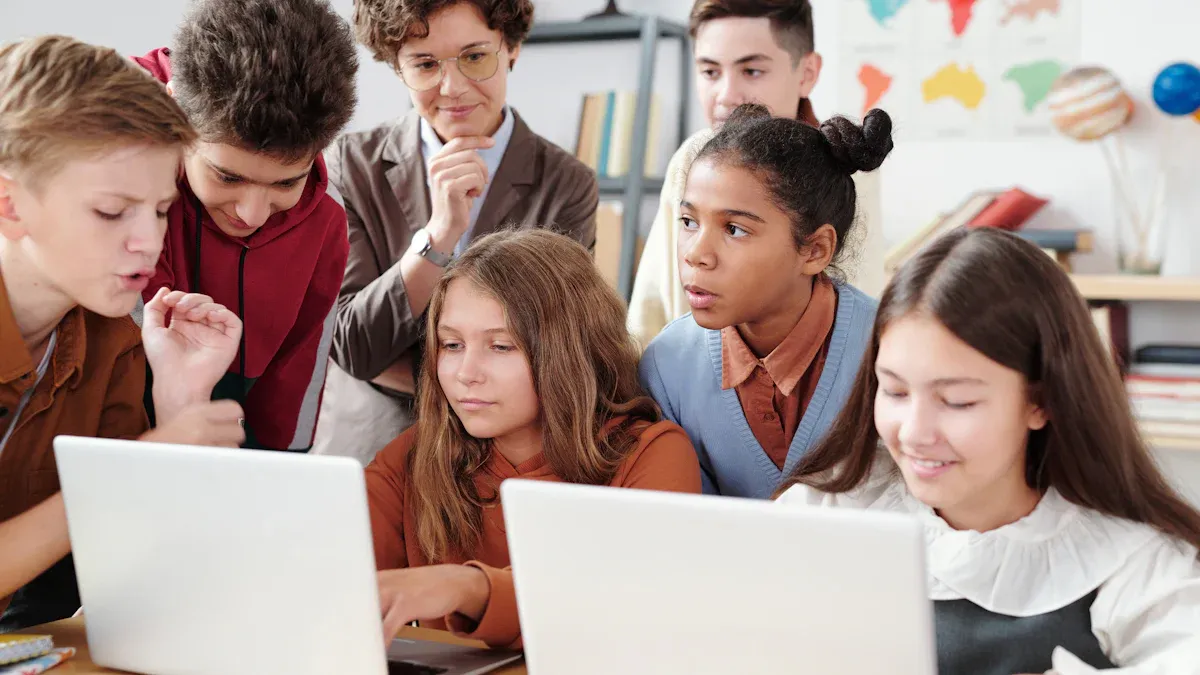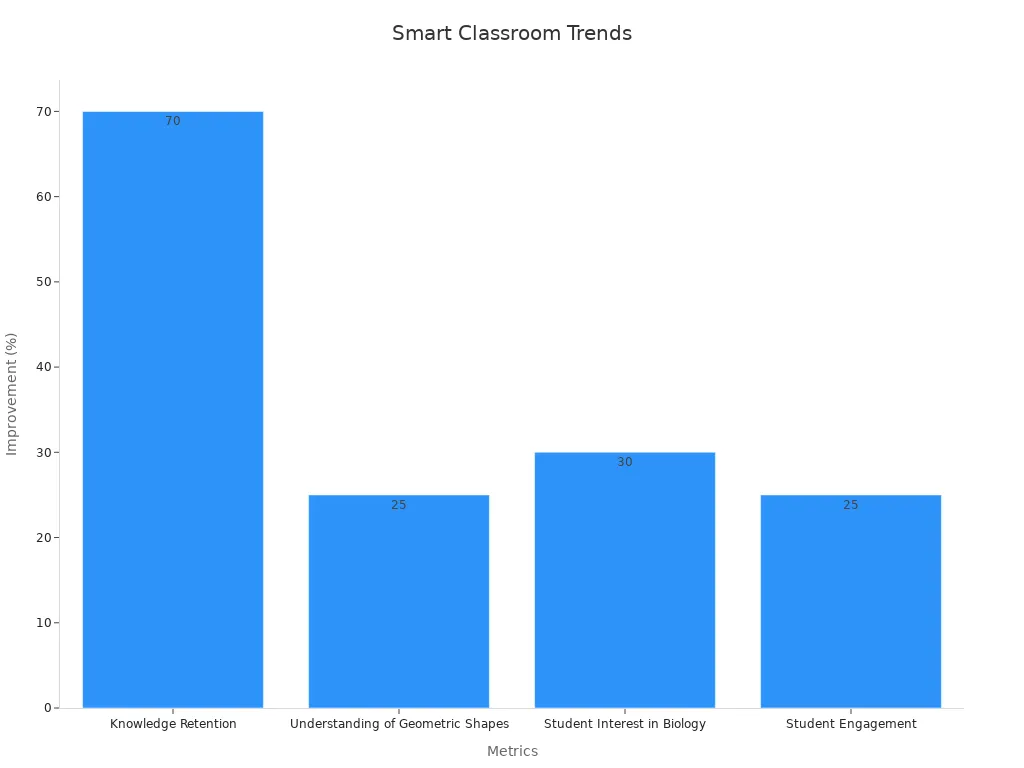
Picture a classroom where technology transforms lessons into engaging and interactive experiences. This is the power of EdTech in a smart class. EdTech, short for educational technology, leverages apps, digital tools, and innovative gadgets to create cutting-edge learning environments. The goal? To help you grasp concepts faster, stay engaged, and truly enjoy the process of learning.
Smart classes rely on EdTech to revolutionize education. They’re not just about flashy screens or high-tech devices; they focus on making learning more accessible and tailored to individual needs. For instance, 74% of teachers report that EdTech helps students maintain focus, while 72% observe improved outcomes with personalized learning tools. These advancements highlight how smart classes are paving the way for the future of education.
EdTech changes learning by using tech to make lessons fun.
Smart classrooms use AI, VR, and screens to teach better.
EdTech tools help students understand hard ideas and stay on task.
LMS tools make it easy to find lessons and homework.
EdTech helps students learn and teachers teach in better ways.
EdTech means using technology to improve how we learn. It’s not just about cool gadgets in classrooms. It’s about tools that help you learn faster and enjoy it more. Think of it as connecting old-school teaching with modern tech. For example, apps can make math fun, and online platforms let you work with classmates. EdTech is changing the way we learn every day.
The EdTech industry is growing fast. In 2023, it was worth over $146 billion. By 2033, it could grow to $549.6 billion. This shows how schools, colleges, and workplaces are using it to make learning better.
EdTech makes learning easier and more accessible for everyone. Teachers can create lessons that fit your learning speed. If a topic is hard, EdTech tools can give extra help or explain it differently. It also makes learning fun and interactive. Instead of just reading, you can watch videos, play games, or explore virtual worlds.
Since 2020, schools using EdTech have increased by 99%. This shows how important it is for modern education. Even big companies use EdTech for training. About 40% of Fortune 500 companies already use it.
You might already use EdTech tools without knowing it. Here are some examples:
Learning Management Systems (LMS): Tools like Google Classroom help teachers share lessons and assignments.
Gamified Learning Apps: Apps like Kahoot! or Duolingo make learning feel like a game.
Interactive Whiteboards: These let teachers show lessons and interact with them live.
AI-Powered Tools: Tools like Grammarly help you improve writing or other skills.
Studies show these tools work well. For example, a college in California used leaderboards to motivate students. This increased assignment completion by 40% and made 80% of students feel more excited to learn.

A smart classroom is a place where technology makes learning exciting. It helps lessons become more fun and interactive. Picture a room with big screens, smart boards, and devices that connect everyone. These classrooms use tools like tablets, projectors, and virtual reality to teach in cool ways.
The main goal isn’t just to look fancy. It’s to help you learn faster and better. For example, instead of reading about planets, you could explore them in 3D. That’s how technology makes learning come alive.
Smart classrooms have awesome tools that make learning fun. Here are some examples:
Interactive Whiteboards: Teachers can write, draw, and share ideas you can join in on.
Digital Displays: Big screens show videos and animations to explain topics better.
Gamified Learning Tools: Games and apps make learning feel like playtime.
Cloud-Based Tools: Access your notes and homework anytime, anywhere.
These tools don’t just make school fun. They also teach you important skills. For example, using technology helps you learn to think creatively and adapt to new tools. You’ll also get better at solving problems and working with data.
Benefit | What It Teaches You |
|---|---|
Digital Literacy | Learn to use apps and online tools easily. |
Data Analysis Skills | Understand and organize information to make smart choices. |
Adaptability | Get used to new tools and changes quickly. |
Creativity and Innovation | Use tools to design projects and think outside the box. |
Fun games and tools keep you interested in learning. | |
Enriched Learning | Advanced tools make learning easier and more enjoyable. |
How is a smart classroom different from a regular one? Let’s compare:
Technology: Regular classrooms use chalkboards and books. Smart ones use tablets and projectors.
Learning Style: In regular classes, you mostly listen and write. In smart ones, you watch videos, play games, and explore simulations.
Accessibility: Smart classrooms let you find materials online. Regular ones use printed handouts.
Engagement: Smart classrooms are more fun because they use visuals and interactive tools.
In short, smart classrooms use technology to make learning exciting and personal. They prepare you for a world full of new tech.
Smart classrooms use advanced tools to make learning fun. Cloud storage helps you access lessons anytime. AI tools check your progress and suggest better ways to learn. These technologies let you study at your own speed and explore topics in cool ways.
The EdTech market is growing fast. Look at these numbers:
Year | Market Size (in billion USD) | Growth (%) |
|---|---|---|
2024 | N/A | |
2025 | 214.73 | 15.6 |
2029 | 445.94 | 20.0 |
This shows how schools are using tech to improve learning. With apps and virtual tools, smart classrooms are becoming common everywhere.
Interactive whiteboards and displays make learning exciting. You can solve problems on a touchscreen or watch videos that explain tough topics. These tools make lessons fun and easy to understand.
Here’s how they help students and teachers:
Benefit | What It Does |
|---|---|
Whiteboards let everyone join in and share ideas. | |
Instant Feedback | Quizzes and polls show how well you understand right away. |
Easy Assessments | Teachers can create fun activities to check your progress. |
Data Tracking | Teachers can see how engaged you are and adjust lessons. |
Improved Grades | Regular checks help track and boost your learning. |
These tools don’t just make school fun. They also help teachers know what you need to learn better.
AI, AR, and VR make learning exciting and personal. AI adjusts lessons to focus on what you find hard. For example, if geometry is tricky, it gives you more practice with shapes.
AR and VR let you explore in 3D. You can visit ancient places or see the human body up close. Studies show these tools improve learning:
Metric | Improvement |
|---|---|
Memory Retention | |
Geometry Skills | 25% better |
Interest in Biology | 30% higher |
Student Engagement | Up to 25% better |

These tools make lessons unforgettable. AR helps you remember more, and VR keeps you interested by showing amazing virtual worlds. AI ensures every lesson fits your needs perfectly.
Learning Management Systems (LMS) and cloud tools change how we learn. They help you find lessons, finish homework, and work with classmates easily. Tools like Google Classroom, Moodle, or Blackboard keep everything simple and organized.
LMS platforms are made to match your needs. Teachers can share lessons, quizzes, and videos for you to learn at your speed. Cloud tools, like Google Drive or Microsoft OneDrive, let you save and share files. You can use them anytime, whether at school or home. This makes learning flexible and modern.
Here are some key facts about these tools:
Statistic | Value |
|---|---|
Projected market growth (CAGR) | 16.2% |
Estimated LMS users globally | 73.8 million |
Percentage of LMSs purchased by tech companies | 30% |
Access via desktop computers | 89% |
Access via laptops | 78% |
Access via mobile devices | 25% |
Online students using personal devices | 76% |
These tools became vital during the COVID-19 pandemic. Schools used LMS platforms to keep classes going online. Remote learning showed how useful these systems are. Even now, they remain important as more schools and companies use digital tools.
LMS and cloud tools make learning fun and interactive. You can join chats, take quizzes, and get quick feedback. This helps you stay interested and learn better. In smart classrooms, these tools work with other tech to make learning smooth and exciting.

EdTech makes learning fun and easier for students. Imagine visiting ancient places using virtual reality or solving math on a smart board. These tools make lessons exciting and help you learn better. Research supports this. For example, Zheng et al. (2020) found tech classrooms improved course completion by 28% and boosted memory by 32%. Freeman et al. (2014) showed tech-based active learning raised exam scores by 6%.
EdTech also adjusts to your learning needs. If a topic is tough, AI tools give extra help. Apps like Kahoot! turn studying into games, keeping you interested. With these tools, learning feels like an adventure, not a task.
Study | Findings |
|---|---|
Zheng et al. (2020) | 28% higher course completion rates and 32% better content retention. |
Freeman et al. (2014) | Active learning with technology increased exam performance by 6%. |
EdTech helps teachers teach better and easier. Tools like Learning Management Systems (LMS) make planning and grading simple. Teachers can see how you’re doing and change lessons to fit your pace. Interactive tools also make classes lively and fun.
Numbers show EdTech improves teaching. Tech classrooms see 93% more students joining in. Off-task behavior drops by 37% with interactive tools. Teachers feel more confident using tech, which improves their teaching.
Metric Description | Result |
|---|---|
Improvement in classroom practices | Statistically significant increase across all measured domains. |
Increase in voluntary participation | |
Reduction in off-task behavior | 37% with interactive learning tools. |
Increase in student motivation |
Schools gain a lot from using EdTech in smart classrooms. It removes distance problems, making learning available to more students. Tools like virtual labs and multimedia make lessons better and prepare you for a tech-filled future.
Schools also save money. Governments and investors are funding EdTech growth. Schools using tech see test scores rise by 15-18% after three years. Better resources and tools help schools adopt smart class systems faster.
More students can learn without worrying about distance.
Multimedia and virtual labs make lessons more interesting.
Governments and investors spend money to grow EdTech.
Test scores improve by 15-18% after three years of using EdTech.
EdTech doesn’t just change classrooms—it changes how schools teach, creating a brighter future for everyone.
EdTech has changed how students learn today. It makes lessons fun, interactive, and suited to your needs. Smart classrooms use tools like AI, VR, and cloud systems. These tools make learning exciting and help you reach goals faster.
To keep improving, schools must solve problems like access and training. Numbers show how useful these tools are. For instance, one school district saw 30% more teachers using EdTech in 60 days with tutorials. This shows that good strategies make EdTech helpful for everyone.
The future of learning is here and thrilling. With smart classroom tech, you’re not just learning—you’re getting ready for endless opportunities.